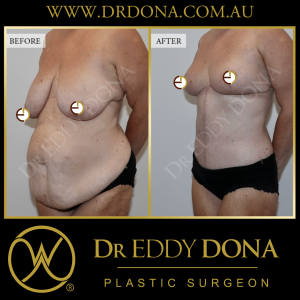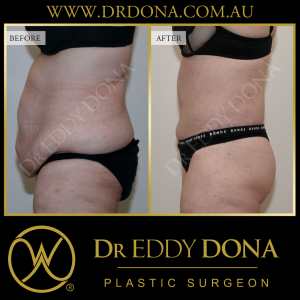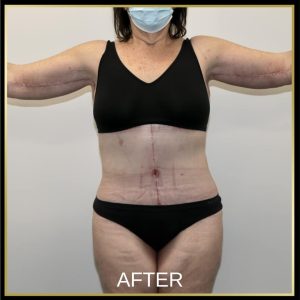Open Book Tummy Tuck™ (Abdominoplasty)
An OPEN BOOK TUMMY TUCK™ (Abdominoplasty) is a RECONSTRUCTIVE procedure designed to address complex issues. It is almost exclusively applied to those individuals who have undergone massive weight loss and suffer from extreme skin excess.
The OPEN BOOK TUMMY TUCK™ (OBTT) procedure is a Tummy Tuck technique that Dr Dona has introduced for his patients. It is a progression from other Tummy Tuck techniques and has been introduced for more complex problems of the abdominal wall (typical after massive weight loss) which often present to Dr Dona’s private practice. Applied to the correct patient, it is an ideal form of abdominal wall reconstruction.
OPEN BOOK TUMMY TUCK™ (Abdominoplasty) case study
In the following video Dr Dona explains the basic reconstructive surgical principles of an OPEN BOOK TUMMY TUCK™ (OBTT). This video was taken immediately prior to surgery after Dr Dona had made his tentative surgical markings. These markings serve as a guide for how much skin (and associated fatty tissue) Dr Dona intends on removing. Dr Dona frequently uses dressmaking as an analogy to help patients understand the ultimate scar pattern that will be necessary to achieve the outcome that an OBTT delivers.
After images shown are generally taken between 3-6 months post-surgery.
The outcomes shown are only relevant for this patient and are not a guarantee that you will have similar results, even if you have a similar body type or shape. Results may vary due to many factors including an individual’s genetics and lifestyle.
Please see our gallery for more examples of the results achievable with an OBTT.
FAQ'S
What is a Tummy Tuck (Abdominoplasty)
Before we discuss the OPEN BOOK TUMMY TUCK™ (Abdominoplasty) any further, we need to understand what a Tummy Tuck (Abdominoplasty) truly means. To do so, one needs to understand the true meaning of the word reconstruction. The reason why this is important is to remove the widely held, albeit false, view by many that a Tummy Tuck is a purely cosmetic procedure. The definition of the word reconstruction is – to return to a state (or create a state) that is normal for that person’s age, race, and gender.
This becomes clearer when dissecting the meaning of the word “normal.” In the context of the human form, normal refers to something functional or acceptable for that particular individual. Excluding those rare individuals with body dysmorphic disorder, ‘normal’ is in the eye of the beholder. The spectrum of normal is broad, meaning what is normal for one person may be abnormal if applied to another. The prevalence of a specific body issue does not make it normal.
Tummy Tuck, surgery is designed to address a number of concerns with the abdominal wall. Keeping the above in mind, it is far more of a reconstructive procedure than a cosmetic procedure.
Why are Tummy Tucks (Abdominoplasty) Requested?
An intact abdominal wall should contain:
- Good skin quality with no scars – whether that be stretch marks (which are in fact scars), surgical or traumatic scars.
- Intact muscle alignment and tone – this ensures functionally sound core biomechanics and strength with a stable lower back and maximal bowel/bladder control.
- No skin excess and overhang with its associated functional and hygiene issues.
- A pubic/mons position that does not have ptosis (droop) and fullness with the potential functional problems significant ptosis can cause.
With this basic understanding, all forms of Tummy Tucks are designed to address any concerns with these areas – to return to a state that is normal for that individual – and is hence by definition a reconstructive surgery.
In other words, a Tummy Tuck is not a cosmetic procedure. Just because an operation makes something look better people will immediately label it cosmetic. However the primary purpose of a Tummy Tuck is to reconstruct, and a secondary bonus is improved aesthetics.
Different types of Tummy Tucks (Abdominoplasty)
The term Tummy Tuck is really a simple term that encompasses any operation that reconstructs the abdominal wall. This is because the degree of problems one has will dictate the type of abdominoplasty that is necessary.
The different names applied to the different Tummy Tucks typically relates to the surgical scars created. Common names include:
- Mini-Tummy Tuck (Abdominoplasty)
- Regular Tummy Tuck (Abdominoplasty)
- Extended Tummy Tuck (Abdominoplasty)
- Fleur-De-Lis Tummy Tuck (Abdominoplasty)
Many variations exist within each type and the above is a very simplistic breakdown.
What is the OPEN BOOK TUMMY TUCK™ (Abdominoplasty)?
Whilst these above Tummy Tuck (Abdominoplasty) options will be an ideal choice for most patients, with the ever-increasing number of people changing their lives with life altering massive weight loss, different options were necessary to reconstruct their bodies.
As such, the Open Book Tummy Tuck™ was an operation born out of necessity. Dr Dona coined the term “Open Book” based on how the abdominal wall appears halfway through the operation – the skin and fatty layers are opened like a book before being closed into its new form.
As is explained by Dr Dona, “when someone loses a massive amount of weight, they become, fitter, healthier and smaller – unfortunately the skin has a limited amount of elasticity and is unable to shrink-wrap around the smaller body.”
Dr Dona goes on to explain, “if you consider the skin to represent an old dress, then effectively you become a much smaller bodied individual walking around with a dress that is way too big for your body. My job is to make your skin fit your body.”
“The Open Book Tummy Tuck allows for a greater amount of excess skin to be removed in areas that other abdominoplasty techniques do not allow.”
Of course, other areas of the body are also reconstructed as required, especially the abdominal wall muscles which usually require significant tightening. Furthermore, the OBTT is often combined with other procedures such as Breast Reductions & Lifts, Total Body Lifts (BELT LIPECTOMIES) and/or BRA LIPECTOMIES.
Applied to the correct patient, an Open Book Tummy Tuck™ is an excellent option in body contouring surgery after massive weight loss.
Surgery & Scars
All surgery involves scars. Whenever a surgeon makes an incision, a scar will form. No magic exists to prevent a scar from forming or to make a scar disappear. The surgeons’ job is to ensure the scars are ideally positioned and have the best chance of healing well.
When it comes to Body Contouring Surgery, in order to understand the scars required to achieve the required outcome, an analogy often used is dressmaking – the surgeon is the tailor, and they need to tailor your skin to fit your smaller body. Dressmaking involves removing material and running seams to create the best pattern/fit. In surgery, those seams are scars. This is a very simplistic analogy to explain a complex operation.
With respect to a Tummy Tuck procedure, the greater thechange required, the greater the size and number of scars necessary. The OBTT is a surgical procedure typically utilised in those individuals who have experienced significant weight loss and therefore require significant reconstruction.
Most Tummy Tucks result in a single scar along the lower abdomen, which is nicely concealed within normal underwear line, and an additional scar around, or within, your belly button. However, sometimes additional scars are required to maximally reconstruct the body and provide optimal shape. A Fleur-De-Lis Tummy Tuck (Abdominoplasty) has a second additional scar along the entire midline of your abdomen up to you lower chest. In addition to the two scars of a Fleur-De-Lis Tummy Tuck, the OBTT has a third scar extending horizontally along the entire lower chest in the lower breast fold. So, in an OBTT you effectively have three scars – a midline scar which joins the lower abdominal and lower chest scars.
OBTT COMBINED WITH OTHER PROCEDURES
Massive weight loss affects every part of the body, with problematic excess skin issues often found in the arms, chest, back, buttocks and thighs. Therefore, surgery to reconstruct these areas is often requested.
However, whilst many patients would like to have multiple operations performed at the same time, this is not always possible. The larger the surgery, the greater the potential for post-operative problems to arise.
Each patient is assessed, and a plan put in place to address their concerns based on priority. It is often not wise to combine operations due to surgical safety issues. These decisions can only be made after a formal consultation and determining an individual’s suitability for surgery, and what type of surgery can or should be performed. For many patients that have lost a significant amount of what, they will often have to undergo surgeries in a staged manner over a period of time.
Of course, other issues such as financial and patients’ lifestyle/logistics also needs to be considered when planning these surgeries.
For some individuals, based on their unique circumstances, it may be possible to combine other procedures with an Open Book Tummy Tuck.
OPEN BOOK TUMMY TUCK™ (Abdominoplasty) & Bra Lipectomy
These are operations designed to remove the excess skin and reconstruct the upper back and upper lateral chest wall – along the bra line. This scar continues along the lower breast fold, along the same line as the upper horizontal scar of an OBTT.
These images are not a guarantee that you will have similar results, even if you have a similar body type or shape. This is because, with each patient, many different variables exist that can affect the outcome including lifestyle and genetics.
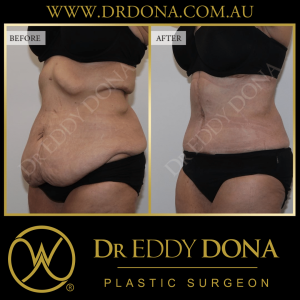
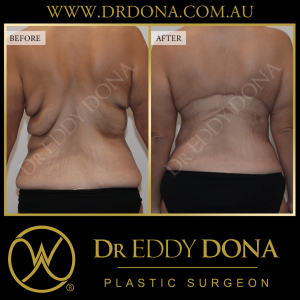
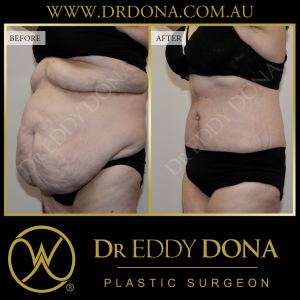
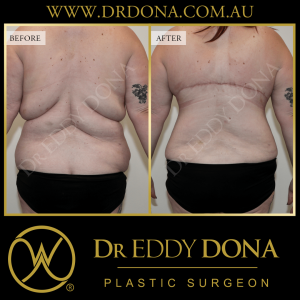
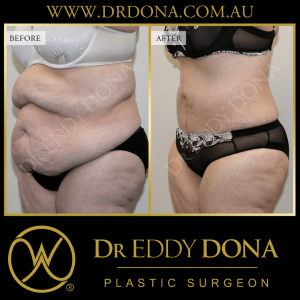
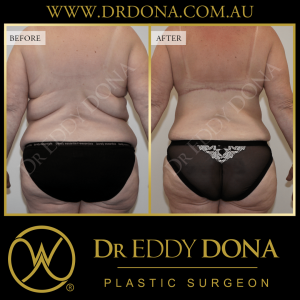
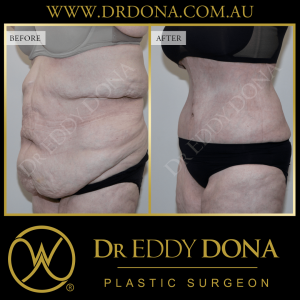
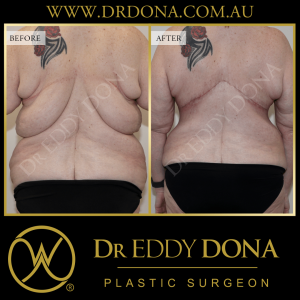
OBTT & Breast Reduction/Breast Lift (Mastopexy)/Breast Augmentation
Any Tummy Tuck (Abdominoplasty), including an Open Book Tummy Tuck (Abdominoplasty) can be combined with surgical procedures to enhance the breasts to enhance size, shape, and form.
These images are not a guarantee that you will have similar results, even if you have a similar body type or shape. This is because, with each patient, many different variables exist that can affect the outcome including lifestyle and genetics.
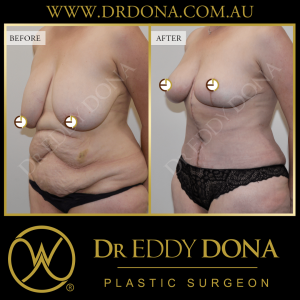
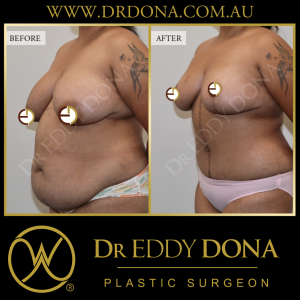
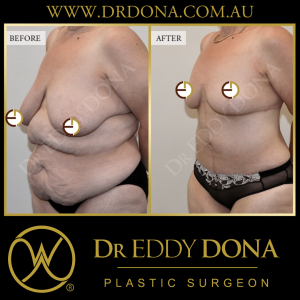
OPEN BOOK TUMMY TUCK™ (Abdominoplasty) & Total Body Lift
Often following massive weight loss, excessive amounts of skin is found along the lower back and upper gluteal region. Surgery to reconstruct this area is referred to as a Total Body Lift, or often known as a Belt Lipectomy.
These images are not a guarantee that you will have similar results, even if you have a similar body type or shape. This is because, with each patient, many different variables exist that can affect the outcome including lifestyle and genetics.
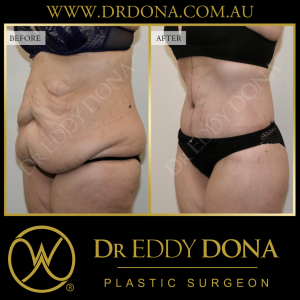
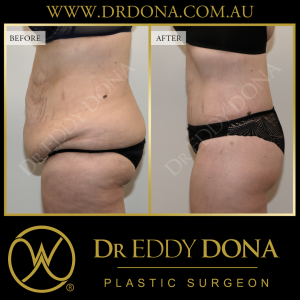
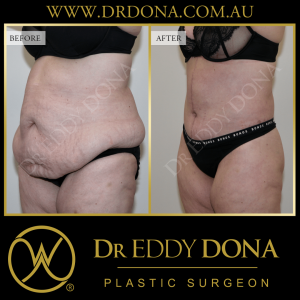
OPEN BOOK TUMMY TUCK™ (Abdominoplasty) & Arm Reduction (Brachioplasty)
One of the commonest areas of concerns following massive weight loss are the arms. Therefore, arm reduction surgery, or Brachioplasty, is often required and in some individuals this can be combined with an Open Book Tummy Tuck (Abdominoplasty).
These images are not a guarantee that you will have similar results, even if you have a similar body type or shape. This is because, with each patient, many different variables exist that can affect the outcome including lifestyle and genetics.
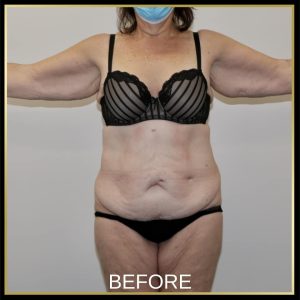
Further surgery – fine tuning
It’s not uncommon for any Tummy Tuck patient to require further surgery to “fine tune” the results.
As far as the scar patterns required, Tummy Tuck surgery is like dressmaking but many times more complex. The skin and tissues are not static and rigid objects. They swell, they stretch, they shrink, they sag etc. In addition to this, the underlying body is also changing.
During surgery Dr Dona is reconstructing and reshaping everything that’s 3D and not static, whilst at the same time making sure that he doesn’t push things too far and make it too tight – because that increases the risk of wounds not healing and breaking down – complications!
With all this in mind, after everything settles and swelling starts to settle and things relax into position, it’s normal for things to be nowhere near as tight as they initially were. Therefore, it’s not uncommon for patients to require further surgery to further improve the results, just like you would for a second fitting of a tailor-made dress. This is especially the case in quite large reconstructions such as an Open Book Tummy Tuck.
With this in mind, you should not undertake any surgery, especially these larger surgical procedures, if you’re not prepared or willing to have further surgery, and the potential time off and costs involved.
Potential Complications
OPEN BOOK TUMMY TUCK™ – general potential complications
All surgical procedures carry the potential risk of wound healing complications – these complications include wound bleeding, infection, wound breakdown or even skin and tissue necrosis or loss. As a result, wound ulceration and wound breakdown can occur. Wound complications can range in minor through to major concerns, that may warrant further surgical and hospital intervention.
With an Open Book Tummy Tuck (Abdominoplasty), the wounds are obviously very large, so these risks are much greater compared to surgery with smaller wounds. Those patients at greatest risk of these potential complications are:
- Elderly
- Overweight
- Diabetics
- Smokers
- Immunosuppressed including those taking certain immunosuppressive medications
For most people without these risk factors, the chances of any significant wound healing problems are quite small.
The areas of greatest concern are located at the very bottom and top of the midline scar where it meets the relevant horizontal scar. These are the areas which have the greatest degree of tension and the poorest blood supply.
The general and specific complications for an OBTT are the same as noted on our Tummy Tuck (Abdominoplasty) page.
Learn more about our procedures or schedule a one-on-one consultation at our Sydney clinic
Call us 1300 DR DONA (1300 37 3662)

